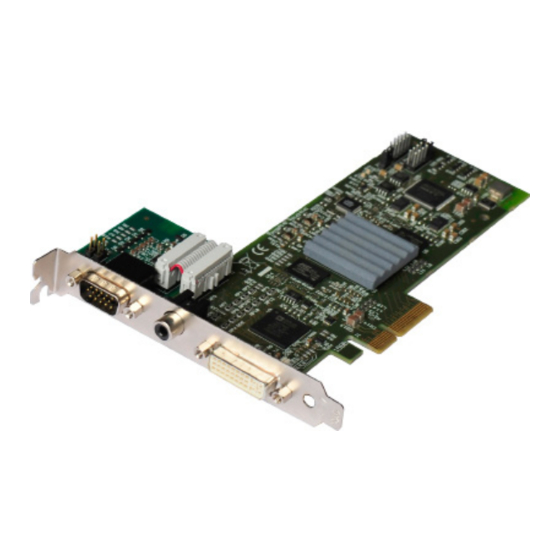Datapath VisionAV/F Manuel de l'utilisateur - Page 7
Parcourez en ligne ou téléchargez le pdf Manuel de l'utilisateur pour {nom_de_la_catégorie} Datapath VisionAV/F. Datapath VisionAV/F 15 pages. Audio/video capture card

Installing the Capture Card
You are likely to need a flat blade and /or a cross head screwdriver for the installation of the
VisionAV card; it would be useful to have these to hand before you begin.
• Power down the PC (including peripherals), switch off at the mains and disconnect all the cables
connected to the computer, noting the positions for accurate reconnection.
• Remove the PC cover.
• For the VisionAV/F capture cards, locate a vacant PCI Express slot (x4 or higher) on the
motherboard and remove the blanking plate (retain all screws).
• If the VisionAV/H is to be installed in a short form computer, two locations are required. The
VisionAV/H and the Audio Module should be installed adjacent to enable both cards to be connected
together using the ribbon cable supplied. The Audio Module does not require a slot on the mother-
board.
If you are in doubt consult your motherboard documentation to correctly identify a PCI Express slot. If
the card is forced into a 32 or 64 bit PCI or PCI-X slot it will be irreparably damaged when the system is
powered up and the warranty will be
• Reconnect all cables to the PC then connect a DVI cable (not supplied) distributing the DVI source
signal to the connector on the VisionAV capture card
• A standard definition signal can be connected to the RCA connector on the VisionAV
• An Audio feed can be connected to the Audio Module via the Audio Breakout Cable
• Power up the PC and commence the software installation
How to Connect Input Sources
The VisionAV/F card has one DVI-I and one RCA (female) connector and one RGB (male) connector on the
Audio Module:
The DVI-I connector supports DVI, HDMI, Component and RGB (VGA) inputs using the supplied adapters
where required.
A DVI input is connected directly into the DVI-I connector which accepts DVI-D (digital) or DVI-A (analog)
inputs:
void.
5
